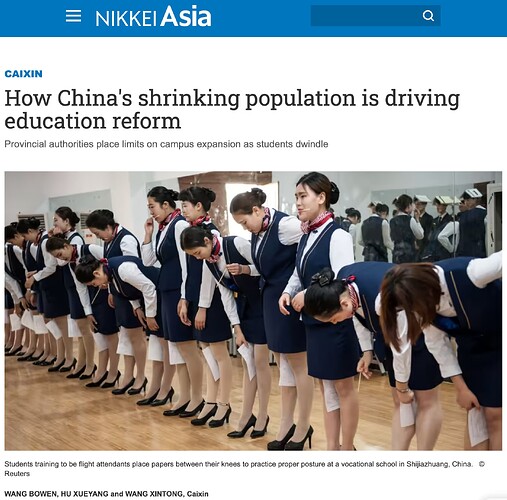中国正在改革其高等教育系统,以应对该国不断变化的经济和人口挑战,重点是职业教育。职业培训培养的工人,如汽车机械师、供暖和空调维修技师、电工、水管工和计算机技术员。政府正在优先考虑职业教育的 "高质量 "发展,并加强职业教育和普通教育的整合。
政府正在增加职业学校的建设,并在一些省份将职业院校升级为授予学士学位的大学。同时,其他省份已经停止了现有大学的扩张计划,以便将更多的资源用于在他们已有的校园里教育学生。
这些变化是中国计划的一部分,以刺激科技行业的创新,并向更复杂的制造业发展,因为中国正在应对威胁其经济未来增长的不断加深的人口困境。
2019年,教育部启动了一个试点项目,批准一批职业院校成为大学。
2021年,中央政府发布指导方针,旨在到2025年将职业大学的招生份额扩大到至少占高等职业教育机构招生总数的10%。
3月,教育部的一位官员在一次新闻发布会上说,中国的职业大学在2022年招收了76,300名新生,比前一年增长了84.39%。
1月,广东省教育厅表示,它正计划向教育部申请将深圳职业技术学院升级为 “职业大学”,这是南方科技中心的一所声誉良好的公立职业学院。
同样,黑龙江、甘肃、江西和湖南等省以及宁夏回族自治区在最近几个月宣布,计划在2025年前将10多所公立职业院校提升为大学。
职业大学像普通大学一样为教授的技能颁发学士学位。它还要求学生接受比其他类型的职业学校更长时间的培训。
但是,尽管有这些努力,职业大学的发展并不顺利,部分原因是这些学校大多是私人经营;它们提供的教育被认为不如公立学校严格。
专家称,这使得学生和他们的父母不愿意选择这些学校。
专家告诉财新记者,职业大学的发展也受到现已放弃的 "零就业 "政策的影响,该政策有时会将数亿人限制在家中。
他们认为,随着深圳职业技术学院等古老的公立职业院校加入改革运动,中国的职业大学将迅速发展。
政府已将重点转移到提高大学的质量而不是数量上,导致几所大学暂停了建设新校区或关闭现有校区的计划。西北工业大学(NPU)和西南交通大学关闭了校园,而哈尔滨工业大学则关闭了研究所。教育部发布了指导方针,不鼓励高校跨省设立新校区,一些地方政府也限制了辖区内新的高等教育机构的数量。
黑龙江省表示,在2025年之前,该省不会建立新的普通高校,广东揭阳表示,他们将不再处理县级政府建立新的公共高等教育机构的申请。教育部长怀进鹏说,迫切需要深入了解人口和社会结构变化对国家教育蓝图和资源分配的影响。中国的人口一直在下降,其出生率降到了历史最低点,导致劳动力萎缩。
职业学校必须在促进制造业方面发挥作用,而普通高校的任务是推动国家的科技创新。学生群体的萎缩将意味着学生正在成为一种 “稀缺资源”,这可能会让教育工作者有时间重新关注优质教学。
China is reforming its higher education system to address the country’s changing economy and demographic challenges, with an emphasis on vocational education. Vocational training produces workers for roles such as auto mechanics, heating and air conditioner repair technicians, electricians, plumbers and computer technicians. The government is giving priority to the “high-quality” development of vocational education and strengthening the integration of vocational and general education.
The government is increasing its construction of vocational schools and upgrading vocational institutions to bachelor’s degree-granting universities in some provinces. Meanwhile, other provinces have halted expansion plans for existing universities in order to devote more resources to educating students on the campuses they already have.
The changes are part of China’s plan to spur innovation in the tech industry and move toward more sophisticated manufacturing, as it deals with deepening demographic woes that threaten the future growth of its economy.
In 2019, the Education Ministry launched a pilot project granting approval to a group of vocational institutions to become universities.
In 2021, the central government issued guidelines aimed at expanding the share of vocational university enrollment to at least 10% of the total enrollment in higher vocational education institutions by 2025.
In March, an Education Ministry official said at a news conference that China’s vocational universities enrolled 76,300 new students in 2022, an increase of 84.39% over the previous year.
In January, the Guangdong provincial education department said it was planning to apply to the Ministry of Education to upgrade Shenzhen Polytechnic, a reputable public vocational college in the southern tech hub, to a “vocational university.”
Similarly, the provinces of Heilongjiang, Gansu, Jiangxi and Hunan, as well as the Ningxia Hui autonomous region, announced in recent months plans to upgrade more than 10 public vocational colleges to university status by 2025.
A vocational university awards bachelor’s degrees like a general university for skills taught. It also requires students to undergo a longer period of training than other types of vocational schools.
But despite these efforts, the development of vocational universities has not been smooth, partly because most of these schools are privately operated; the education they provide is not considered as rigorous as that of public schools.
This makes students and their parents reluctant to choose them, according to experts.
The growth of vocational universities has also been affected by the now-abandoned “zero-COVID” policy, which at times confined hundreds of millions of people to their homes, the experts told Caixin.
They believe that with venerable public vocational institutions like Shenzhen Polytechnic joining the reform movement, China’s vocational universities will grow quickly.
The government has shifted its focus to improving quality of universities rather than quantity, leading to several universities suspending plans to build new campuses or close existing ones. Northwestern Polytechnical University (NPU) and Southwest Jiaotong University have closed campuses, while Harbin Institute of Technology has closed research institutes. The Education Ministry has released guidelines discouraging colleges and universities from setting up new campuses across provinces and some local governments have limited the number of new higher education institutions in their jurisdictions.
Heilongjiang province has said no new general colleges or universities will be established there until 2025 and Guangdong’s Jieyang said they would no longer process applications from prefectural governments to set up new public higher education institutions. Education Minister Huai Jinpeng said it was urgent to gain insight into the impact of demographic and social structural changes on the country’s educational blueprint and resource allocation. China’s population has been falling and its birthrate dropped to a record low, leading to a shrinking workforce.
Vocational schools have to play a role in boosting manufacturing, while general colleges and universities are tasked with driving the country’s tech innovation. The shrinking student cohort will mean that students are becoming a “scarce resource,” which may open up educators’ time to refocus on quality teaching.
